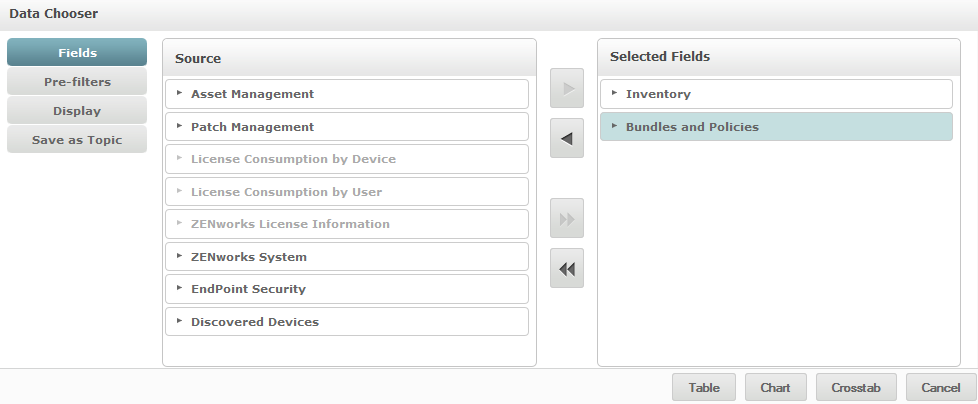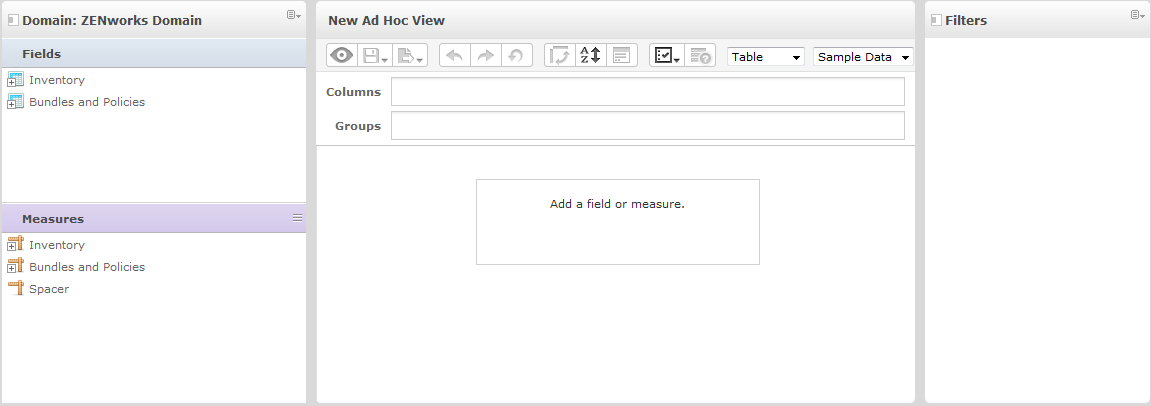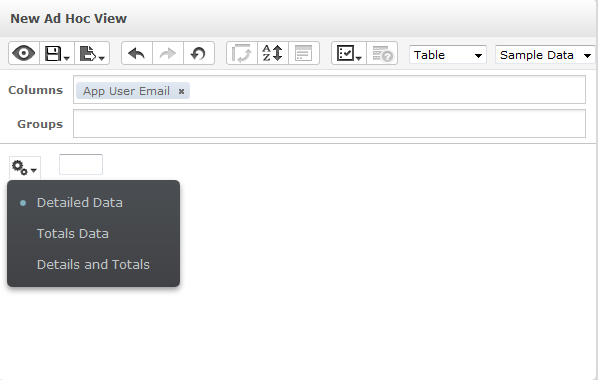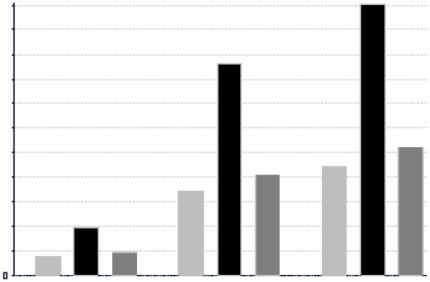2.1 Overview
The Ad Hoc Editor enables you to create various types of reports such as tables, crosstabs, and charts. You can create reports by dragging and dropping the items. You can add and summarize items, define groups, label and title the report, and format data for each item. You can also use the editor to explore and analyze data interactively.
2.1.1 Data Sources
The following repository objects provide connections to data sources for Ad Hoc View creation:
-
Domains: These are collections of objects mapped to database schema. Domains are available for various ZENworks products such as ZENworks Configuration Management, Audit Management, and ZENworks Mobile Management.
-
Topics: Topics are created as JRXML files and then associated with data sources in the server. A topic can also be created from a domain in the server. For more information about Topics, see the Jaspersoft Server User Guide.
2.1.2 Using the Data Chooser
After selecting the data source, the Data chooser is displayed.

You must select items from the the Source to Selected Fields, to enable Pre-filters, Display, and Save as Topic buttons. The Pre-filters, Display, and Save as Topic features are optional and can be used in any order. Click Table, Chart, or Crosstab at any time to design a view based on the chosen data.
See the following sections for additional information about Data Chooser:
Selecting Items
Click Fields to select items and sets of fields to use in the view, or to make available in the Domain Topic.
-
The Source panel displays the sets of fields from the Domain. Use the
 and
and  icons to close or expand each set.
icons to close or expand each set.
-
The Selected Fields panel displays the items selected from the Source panel. To move a field between the panels, you can drag, double-click, or select the items, and click an arrow button.
Pre-filtering data
You can pre-filter data in the Data Chooser wizard before clicking Table, Chart, or Crosstab, or before clicking Save as Topic. Pre-filtering data limits the data choices available in a Domain Topic or the fields that display in the Ad Hoc View. You can define a filter for fields that are not displayed in the final report. The filter that meets all defined criteria will be displayed in the final report. You can also design reports that prompt users to specify input data to use as filters.
The Pre-filters panel provides a powerful functionality for designing views within the server.
To define a filter:
-
In the Data Chooser wizard, click Pre-filters.
-
Expand the options in the Fields panel.
-
Double-click to select a field.
-
Choose a comparison operator.
Text fields have substring comparison operators, such as starts with or contains, and whole string matching operators, such as equals, or is one of. When you select a whole string matching operator, all existing values for the selected field are displayed; retrieved in real-time from the database.
In the Filters panel, a drop-down list is displayed. The list contains the account names from which you can select multiple values.
-
In Available Values, click each value and move it to Selected Values for comparison.
If there are more than 50 values to display in Available Values, click
 to search for the value. You can configure the maximum number of items that can be displayed in Available Values.
to search for the value. You can configure the maximum number of items that can be displayed in Available Values.
-
Select the Locked check box to limit the view in Selected Values.
By default, the Locked check box is cleared, enabling end-users to use filters when they run the report.
-
Click OK.
-
In the Filters panel, click Change to modify the condition.
-
Click OK to save the changes.
To delete from a list, select a row, then click Remove.
NOTE:Data rows must match all conditions. The filter applied to the data must be a logical AND operator for all the conditions that you have defined.
Changing the Default Label Settings
Use the Display panel to change the default label and order of the fields in the Ad Hoc Editor. In the Ad Hoc Editor, you can change the field labels and ordering at any time. However, if you configure the settings the changes will be updated in the Domain Topic.
The Display panel includes the following options:
-
To change the order of fields, click in the row of the required field. Then, based on the required position, use the Move to top, Move up, Move down, or Move to bottom buttons.
Fields can be moved within a set, and sets can also be moved.
-
By default, the field name turns into the display label for the row, column, or measure that you create from the given field. To change the default display label of a field or set, double-click the row and specify the new label in the text box.
-
Sets are not used in views. However, to quickly create a view, you can use sets to add all the fields together.
-
If you do not want to use sets in the Ad Hoc Editor, select Flat List at the top of the Data Source Selection panel. You can then relabel the fields and reorder them.
Saving the Settings
On the Save as Topic panel, you can specify a name and description to save the Data Chooser settings as a Domain Topic. After saving these settings, you can create different views from the Domain Topic, using its fields, filters, and display label settings. You can also edit the Domain Topic to change the settings.
2.1.3 Ad Hoc Editor Panel
The Ad Hoc Editor enables you to create various types of views and reports.
Figure 2-1 Ad Hoc Editor

The Ad Hoc Editor panel includes the following:
The Data Source Selection Panel
The Data Source Selection panel contains a list of items that are selected from a Topic or Domain and are placed in Fields and Measures.
To hide or unhide this panel, click the Data Source Selection icon in the top-left corner. The Hide option helps you to arrange content in a large Ad Hoc View.
The Ad Hoc View Panel
The Ad Hoc View panel provides tools that enable you to control and organize the data that is included in a view.
Figure 2-2 Ad Hoc View panel

See the following sections for more information about the Ad Hoc View panel:
Ad Hoc Editor Tool Bar Icons
|
Icon |
Name |
Description |
|---|---|---|
|
|
Display Mode |
To hide the editor interface. This mode provides a subset of the editor’s full feature set. |
|
|
Save |
To select save options. |
|
|
Export |
To export the report into the following formats: PDF, Excel (Paginated), Excel, CSV, DOCX, RTF, Flash, ODT, ODS, XLSX (Paginated), XLSX (Paginated), and XLSX. |
|
|
Undo |
To undo the most recent action. |
|
|
Redo |
To redo the most recently undone action. |
|
|
Undo All |
To revert the view to its previous state before you last saved. |
|
|
Switch Group |
To change the display groups mode. For example, if Columns display the Bundle Type and Rows displays the Bundle Version and Bundle Create Date, when you click this icon the column information will be displayed as rows and vice versa. This is enabled only for Crosstab View and Chart View. |
|
|
Sort |
To sort data in tables. For more information, see Sorting Tables. |
|
|
Input Controls |
To see the input controls applied to the view. For more information, see Section 2.8.2, Using Input Controls. |
|
|
Page Options |
To select the page-level options:
|
|
|
View SQL Query |
To verify the data. To perform this acton, you must have administrator rights. The query is read-only, but can be copied to a clipboard or other document for review. It is disabled by default. To enable the query, click Manage > Server Settings > Ad Hoc Settings, then select the Enable View Query in Ad Hoc Editor check box. |
|
Drop-Down |
|
The Layout Band
Below the Toolbar is the Layout Band, with the following fields:
-
For Table View, the available fields are Columns and Groups.
-
For Charts and Crosstabs Views, the available fields are Columns and Rows.
Depending on the View, these fields have different labels and functions. You can drag and drop items from Fields and Measures in to Ad Hoc View.
Grid Detail Selector
Below the Layout Band is the Grid Detail selector. This option is available only for Chart View or Table View. In Table View, click ![]() to select the following options:
to select the following options:
-
Detailed Data
-
Totals Data
-
Details and Totals
The Filters Panel
The Filters panel displays filters that are defined for the View. You can set the filter values and view the results in the Ad Hoc View panel. To hide and unhide the Filters panel, click the Filter icon in the top-right corner of the Filters panel.
For more information, see Section 2.8, Using Filters and Input Controls.
2.1.4 Ad Hoc View Types
The Ad Hoc Editor allows you to select the following View types:
Tables
Table views are used to view values in the database and to summarize the values in columns. The table view consists of columns, rows, and groups.
Using groups, rows can be grouped by identical values in any field with intermediate summaries for each grouped value. For example, a table view of bundle details contain columns that indicate the Bundle Name, Version, and Create Date of each bundle, and its rows display the Bundle Type.
|
Bundle Type |
Bundle Name |
Version |
Create Date |
|---|---|---|---|
|
|
|
|
|
Patch Bundle |
B1 |
0 |
09-06-2013 |
|
Windows Bundle |
B2 |
1 |
30-04-2013 |
|
Linux Bundle |
B3 |
1 |
18-08-2013 |
For more information, see Section 2.5, Working with Tables.
Charts
Chart Views compare one or more measures across multiple sets of related items. Charts summarize data graphically and support chart types such as bar chart, line chart, area chart, and pie chart.
For example, in the following table, the Chart tab indicates the data in a bar chart that compares the Bundle Count for each Bundle Type.
|
|
|
Bundle Type |
|
|
For more information, see Section 2.6, Working with Charts.
Crosstabs
Crosstabs are more compact representations than tables; they provide data for items and their computed values. Columns and Rows specify the dimensions for grouping; cells contain the summarized measurements.
For example, in a Crosstab with columns grouped by Bundle Type, the Bundle Count is as follows:
|
Bundle Type |
Bundle Count |
|
Patch Bundle |
100 |
|
Windows Bundle |
150 |
|
Linux Bundle |
50 |
|
Totals |
300 |
For more information, see Section 2.7, Working with Standard Crosstabs.

 Patch Bundle
Patch Bundle  Windows Bundle 02
Windows Bundle 02  Linux Bundle
Linux Bundle